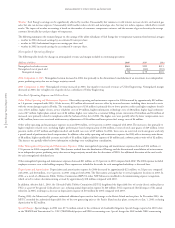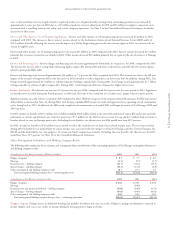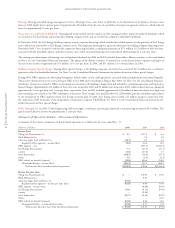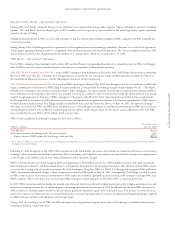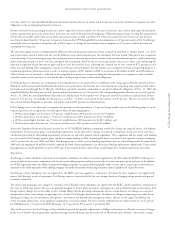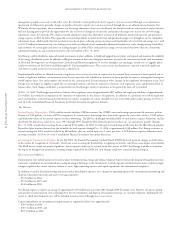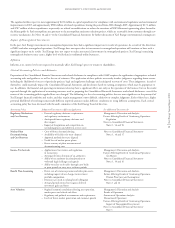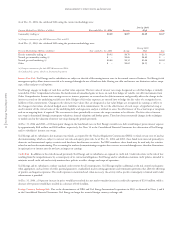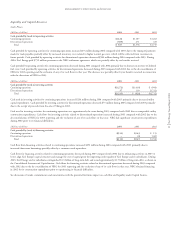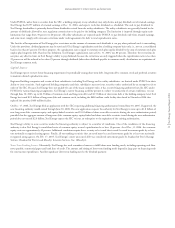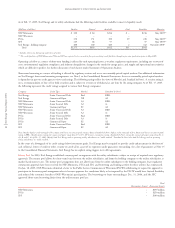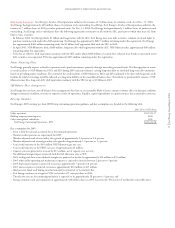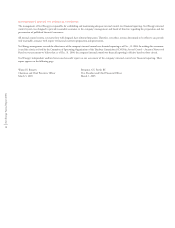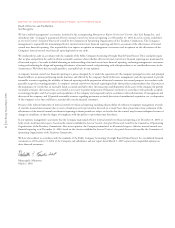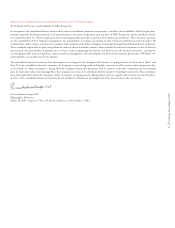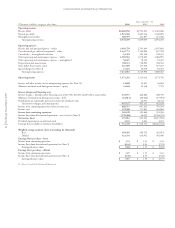Xcel Energy 2004 Annual Report Download - page 34
Download and view the complete annual report
Please find page 34 of the 2004 Xcel Energy annual report below. You can navigate through the pages in the report by either clicking on the pages listed below, or by using the keyword search tool below to find specific information within the annual report.
MANAGEMENT’S DISCUSSION and ANALYSIS
Xcel Energy Annual Report 2004
32
As of Dec. 31, 2004, the calculated VaRs using the current methodology were:
During 2004
Current Methodology (Millions of dollars) Year ended Dec. 31, 2004 Average High Low
Commodity trading (a) $0.29 $0.97 $2.09 $0.27
(a) Comprises transactions for NSP-Minnesota, PSCo and SPS.
As of Dec. 31, 2003, the calculated VaRs using the previous methodology were:
During 2003
Previous Methodology (Millions of dollars) Year ended Dec. 31, 2003 Average High Low
Electric commodity trading (a) $0.92 $0.70 $1.51 $0.29
Natural gas commodity trading (b) $ – $0.06 $0.89 $ –
Natural gas retail marketing (b) $0.08 $0.32 $1.00 $0.02
Other $ – $0.02 $0.15 $ –
(a) Comprises transactions for both NSP-Minnesota and PSCo.
(b) Conducted by e prime, which is a discontinued operation.
Interest Rate Risk Xcel Energy and its subsidiaries are subject to the risk of fluctuating interest rates in the normal course of business. Xcel Energy’s risk
management policy allows interest rate risk to be managed through the use of fixed rate debt, floating rate debt and interest rate derivatives such as swaps,
caps, collars and put or call options.
Xcel Energy engages in hedges of cash flow and fair value exposure. The fair value of interest rate swaps designated as cash flow hedges is initially
recorded in Other Comprehensive Income. Reclassification of unrealized gains or losses on cash flow hedges of variable rate debt instruments from
Other Comprehensive Income into earnings occurs as interest payments are accrued on the debt instrument and generally offsets the change in the
interest accrued on the underlying variable rate debt. Hedges of fair value exposure are entered into to hedge the fair value of a recognized asset,
liability or firm commitment. Changes in the derivative fair values that are designated as fair value hedges are recognized in earnings as offsets to
the changes in fair values of related hedged assets, liabilities or firm commitments. To test the effectiveness of such swaps, a hypothetical swap is
used to mirror all the critical terms of the underlying debt and regression analysis is utilized to assess the effectiveness of the actual swap at inception
and on an ongoing basis, if required. The assessment is done periodically to ensure the swaps continue to be effective. The fair value of interest
rate swaps is determined through counterparty valuations, internal valuations and broker quotes. There have been no material changes in the techniques
or models used in the valuation of interest rate swaps during the periods presented.
At Dec. 31, 2004 and 2003, a 100-basis-point change in the benchmark rate on Xcel Energy’s variable rate debt would impact pretax interest expense
by approximately $6.8 million and $0.8 million, respectively. See Note 14 to the Consolidated Financial Statements for a discussion of Xcel Energy
and its subsidiaries’ interest rate swaps.
Xcel Energy and its subsidiaries also maintain trust funds, as required by the Nuclear Regulatory Commission (NRC), to fund certain costs of nuclear
decommissioning, which are subject to interest rate risk and equity price risk. As of Dec. 31, 2004 and 2003, these funds were invested primarily in
domestic and international equity securities and fixed-rate fixed-income securities. Per NRC mandates, these funds may be used only for activities
related to nuclear decommissioning. The accounting for nuclear decommissioning recognizes that costs are recovered through rates; therefore fluctuations,
in equity prices or interest rates do not have an impact on earnings.
Credit Risk In addition to the risks discussed previously, Xcel Energy and its subsidiaries are exposed to credit risk. Credit risk relates to the risk of loss
resulting from the nonperformance by a counterparty of its contractual obligations. Xcel Energy and its subsidiaries maintain credit policies intended to
minimize overall credit risk and actively monitor these policies to reflect changes and scope of operations.
Xcel Energy and its subsidiaries conduct standard credit reviews for all counterparties. Xcel Energy employs additional credit risk control mechanisms
when appropriate, such as letters of credit, parental guarantees, standardized master netting agreements and termination provisions that allow for offsetting
of positive and negative exposures. The credit exposure is monitored and, when necessary, the activity with a specific counterparty is limited until credit
enhancement is provided.
At Dec. 31, 2004, a 10-percent increase in prices would have resulted in a net mark-to-market increase in credit risk exposure of $23.4 million, while a
decrease of 10 percent would have resulted in a decrease of $14.4 million.
Foreign Currency Exchange Risk Due to the discontinuance of NRG and Xcel Energy International’s operations in 2003, as discussed in Notes 3 and 4
to the Consolidated Financial Statements, Xcel Energy no longer has material foreign currency exchange risk.


